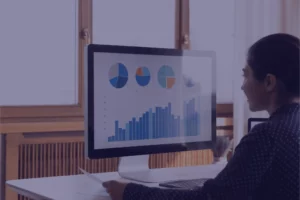4 customer acquisition challenges (and how to solve them)

Customer acquisition is the lifeblood of any business, but it isn’t always plain sailing for marketers as they attempt to boost their acquisition metrics.
In this blog, we consider some of the key issues marketers are facing right now, along with some suggested solutions including:
Free download: A Complete Guide to Customer Acquisition
4 customer acquisition challenges facing marketers right now
Here are 4 of the main challenges that marketers are facing around acquisition with some thoughts on how to address them.
Getting seen in an increasingly overcrowded marketplace
One of the key challenges for brands at the moment is how to ensure they are seen and heard. In what is an increasingly noisy and busy advertising landscape for consumers.
Getting to a true and accurate estimate of the number of adverts that the average individual sees on a daily basis is challenging, as explained succinctly by the Drum, it’s clear that anecdotal estimates of up to 10,000 ads per day are way over the top.
What is not in dispute, is that we are exposed to hundreds and hundreds of ads in the course of a normal day. And the figure is likely to be markedly up from ten or 15 years ago, as the dominance of print, offline display, out of home and traditional print have been challenged (and added to) by a plethora of digital touchpoints that range from paid social to digital TV and beyond. The actual extent to which consumers are exposed to ads is going to differ based on a number of demographic and lifestyle criteria – for example, younger people are likely to see more adverts as they jump from one app or search journey to another. But is safe to say that ad intrusion on our daily routines is significant.
This creates a number of challenges for advertisers, not least getting their message heard above the noise. But there are tangential issues to deal with too as consumer trust in advertisers continues to be eroded (a series of reports by Credos suggests that trust in advertisers has been steadily falling) and many consumers choose to block adverts through a combination of means – from ad blockers on browsers to enabling ad-free options on devices like smartphones.
How to overcome this challenge
The answer for brands partly lies in the quality of the creative ‘cut-through’ in their messaging and ads but it is also key that they rebuild trust with consumers by:
- Ensuring relevancy – the age of spray and pray and one-size-fits-all marketing are gone. According to McKinsey 71% of consumers expect companies to deliver personalized interactions and 67% get frustrated when this happens. So, ensuring ad relevancy through high quality targeting, measurement and adjustment of marketing campaigns is key.
- Understanding the complexity of customer journeys – the reality for marketers is that consumers are increasingly on multi-device and multi-channel journeys. It is key that marketers understand how they are influencing and impacting those journeys. Not just right down at the point of purchase – where many consumers are increasing irritated by the repetitive and relentless nature of advertising tactics like retargeting – but right across the piece.
The impact of rising paid media costs
Customer acquisition can be a costly business at any time.
However, a tide of steady increase in CPAs means that marketers are seeing ad costs rise and ROI being impacted over time.
There are a number of factors driving this including:
- Lingering impact of rises during the pandemic – in terms of recent history there is little doubt that the pandemic had a marked effect in terms of inflating CPA costs, particularly in sectors like retail brands scrambled to mitigate the commercial impact of lockdowns etc.
- Increasing competition – there is also increasing amounts of competition for what is a limited amount of ad space and inventory. This is, in part, being driven by AdTech providers many of whom focus on measurement at the lower part of the funnel. Using narrow attribution approaches like Last-Click which overstate the impact of the last touchpoint before sale subsequently increases competition for this type of space and drive CPA prices as a result.
- Poor quality attribution – like the examples above, are also the tip of the iceberg and poor attribution right across the funnel continues to result in the over-valuation of media and rising CPA levels.
How to overcome this challenge
Here are just a few ways that marketers can address these issues:
- Break down data silos – the way to truly understand the impact of each and every element in your marketing mix is to move away from siloed approaches to measurement and reporting. This has channels like Google allocating 100% conversion credit to the last touchpoint with the customer while Facebook is identical value to an ad ‘view’ at the start of the very same customer journey. What you need is a single view right across the journey that measures the impact of each and every touchpoint that contributes to sale.

If you are still not convinced this is an issue then consider the example on the right from one of our clients – where Google is reporting £20k revenue for the same campaign that Facebook is attributing £450k to.
- Leverage cheaper CPAs further up the funnel – using a journey based approach to attribution enables you to reach up and value early touchpoints on the customer journey, and adjust your analysis to take advantage of cheaper CPAs in the consideration phase.
This is the approach we took for a major electronics retailer as outlined below using the Google ‘See/Think/Do/Care’ model.

By using AI and Machine Learning techniques, like the ones used by our Corvidae platform it was possible to target users further up the funnel at the ‘See’ phase – where CPAs are much lower. Which enabled us to reduce CPAs by an incredible 87.5%.
Low customer retention rates
As you are looking at your customer acquisition metrics what you are bringing through the front door is only one part of the equation.
The reality is that, regardless of how good your acquisition strategy is, if you are churning customers – just as quickly as you bring them in – then your customer acquisition figures are going to come under pressure and invite scrutiny you don’t need.
If you can get the balance right here the business incentive is clear to see as consumers you have a relationship are more likely to listen to what you have to say and act on it accordingly. According to Semrush, the probability of selling to an existing customer is between 60% and 70% but this figure falls through the floor to between 5% and 20% for new customers. So, the more customers you retain, the better chance you have of selling to them and the more revenue you make. It’s a virtuous circle.
How to overcome this challenge
Here are just a few ways that marketers can address these issues:
- Align marketing and customer experience – expectation management is everything here and it is vital that your marketing messaging is pitched at the right level – and aligned with the type of experience the customer is likely to have with your product or service. Aim too high with your messaging, and then fail to deliver when the customer places an order on your online storefront, and it is a safe bet the relationship is only going to go one away.
- Map the entire journey out – this type of approach is borne out of the realization that the customer journey doesn’t end with a successful sale. More than ever, the experience that the customer has post-sale is just as, if not more, important than how they found you. So, ensure that you have a clear plan for customer satisfaction and retention. Approaches like the Flywheel from Hubspot provide good frameworks for mapping this out.
The ongoing impact of regulatory and industry issues
It is fair to say that the recent past has seen its fair share of regulatory and industry wide issues that have impacted customer acquisition efforts.
Some of the main ones include:
- GDPR – For many brands the advent of GDPR caused a myriad of issues as marketers were forced to clean and purge huge swathes of data to ensure regulatory compliance – and with all of the attendant issues that this had for acquisition targeting activity. But GDPR continues to cast a shadow for many marketers, and in particular those using Google Analytics, with the news that GA has been declared illegal in a number of countries in the EU – due to concerns about Google’s inability to restrict access to data by US law enforcement officials.
- The iOS 14.5 update – The decision by Apple to ask users to ‘opt-in’ (as opposed to the previous ‘opt-out’) for targeted advertising as part of its iOS 14.5 update has had a significant impact on the advertising industry. The decision was in part driven by increasing concerns from consumers around privacy and how their data was being used for advertising purposes.
In the face of the fact that 90% of users were declining access to app tracking, one of the biggest losers from the change were those marketers using Facebook ads, with performance nosediving due to a combination of:
- poorer targeting – due to reduced tracking and the impact on audience data
- inaccuracies in reporting – post iOS 14.5 many marketers reported big discrepancies in ROAS and CPA metrics (although it is worth pointing out that marketers were concerned about bias in AdTech reporting prior to iOS 14.5)
- lack of optimization capability – due to reductions in the number of events being tracked
- Removal of third party cookies – as we hurtle towards the latest deadline of Q4 2024 set by Google for the removal of third-party cookies marketers are being forced to review their analytics and attribution options.
A combination of privacy and security concerns, and high profile investigations like the Irish Data Protection Commission (IDPC) review of Google’s online advertising approach, are potential driving factors behind a decision which has huge implications for marketing acquisition activity. With the prospect of dwindling access to third party audiences and a reduction in ad targeting and tracking capability looming.
While Google is proposing a number of replacement solutions – including the Topics and Fledge APIs – early industry responses to them remains lukewarm for a number of reasons ranging from reductions in targeting capability to ongoing concerns about compliance.
How to overcome these challenges
Given the current state of flux that is being caused in the industry, due the combined effect of the issues above, it is clear that marketers need to be looking to future proof their analytics and attribution capability – to help insulate themselves from the impact of the changes.
Concerns about the compliance, legality and the limitations of existing solutions is prompting many to explore GDPR compliant, cookieless solutions that will be better placed to meet the needs of a changed landscape.
Boosting your customer acquisition activity with Corvidae
Corvidae, our patented cookieless attribution solution, is ideally placed to meet the challenges around customer acquisition.
It enables marketers to achieve new levels of marketing performance by:

- enabling you to see the true impact of your marketing efforts right across cross-device, cross-channel customer journeys
- helping you to make better informed budget decisions by reallocating spend, reducing CPA levels and increasing campaign ROAS
- removing the need for cookie-based tracking and using AI and Machine Learning to deliver an average of +95% predictive data accuracy
- breaking down the impact of AdTech data silos by completely rebuilding your broken marketing
- being GDPR compliant ‘out of the box’
Need to learn more? Why not discuss your acquisition and attribution challenges with one of our experts today?



